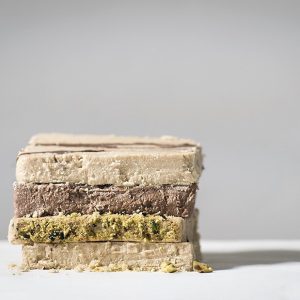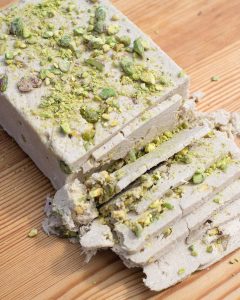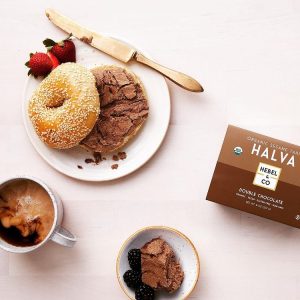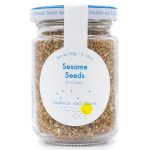Authentic artisan halva made in Los Angeles

Halva, or halvah (or halwa… or any number of other spellings!), is a delicious confection that originated in the Middle East. We’re particularly smitten with the flaky, cottony, crispy, airy, melt-on-your-tongue lusciousness of Hebel & Co halva. Katie Gurvin and Scott Hebel are the husband and wife team behind this delicious halva, which they handcraft in Los Angeles, California with organic ingredients, no preservatives, and no artificial flavors.
What Is Halva?
Hebel & Co’s halva is a sesame tahini-based halva. While halva is typically made with a sesame or nut base, there can be a wide range of differences in halva based on the quality of ingredients used and their ratios. (Certain parts of the world make something called halva that’s entirely different. For instance, Scott shared that there’s carrot-based halva in India and semolina-based halva in Iran.) Their halva is very tahini-forward in flavor and is made with a tahini from Ethiopia that uses roasted and hulled sesame seeds. Of the tahini Scott says, “It’s considered the world’s finest. It has a sweet, nutty taste on its own as opposed to what you might normally find, more of a bitter note from other regions of the world.”
The distinctive cottony, melt-in-your-mouth texture of their halva requires precise handling to achieve. Katie and Scott compared it to bread dough and the knowledge and experience needed to know how to handle it, knead it, shape it, and deal with varying environmental factors. As Scott explains,
“You have to understand the feel of it as you’re making it—what’s happening, if it’s transforming one way or another, quickly or slowly—so it’s a labor-intensive affair to craft halva. And you really have to become an expert, or a master, so to speak, of the craft to make a halva that has this texture.”
The History of Hebel & Co
Scott grew up eating halva; his parents introduced him to it when he was very young and it was an important part of weekend brunch. As Scott explains, it’s what he knew to be normal, and assumed that halva was just available everywhere, but that wasn’t the case. Katie hadn’t heard of halva until he introduced her to it, but she fell in love with it as soon as she tried it. One day Scott asked Katie, “Why is all the halva in this country (America) not awesome?'” so they started down the path of creating their business.
It was about five years ago when they officially started Hebel & Co, but a lot of research and recipe testing happened for years prior to that. Scott admitted that we went down a rabbit hole of halva-making; he would email notes to Katie about what recipes he tried and what worked (or didn’t), and taught himself how to make a high-quality halva. Reminiscing about that time Katie says, “Luckily I don’t care about messes, or else the halva company wouldn’t be around. Would’ve put the kibosh on it—every day the kitchen was a mess.” Luckily for all of us, they persevered and refined their recipes!
4 Fabulous Flavors
The best-tasting food always starts with good ingredients. Hebel & Co carefully selects organic and premium ingredients and they make every batch by hand. Their products are vegan, GMO-free, certified kosher, and free of soy. All of the flavors we carry here at the Deli are gluten-free, too.
Vanilla
For the purist. With rich notes of tahini, molasses, and real Madagascar vanilla, this is the ultimate classic halva flavor. It is your canvas to create your Chagall, or you can just eat the canvas.
Pistachio

One of Hebel & Co’s original flavors, it includes a mix of whole and chopped pistachios from a local organic farm—and nigella seeds, for a unique spin on a classic flavor. Nigella seeds are “sort of pungent, oniony, bitter, sweet, floral all at the same time,” says Scott, adding, ”It’s one of my favorite spices. And it just goes really well with sesame and pistachio.”
(Fun fact, nigella is also known as chernushka, which you’ll find in Chernushka Rye bread, a special bake that Zingerman’s Bakehouse makes a few times a year.)
Double Chocolate
The most chocolatey halva on this planet—made with the most robust, beautiful, organic, deep, dark, high-cocoa-content outrageously chocolatey chocolate. The chocolate notes are complex: rich, decadent, fudgy, and titillatingly almost nutty.
Superseed
One of their newest flavors, inspired by Scott’s love of seeded breads. Superseed has the perfect amount of savory-sweet-nuttiness; with little pops of crunchy delectable seeds and the airy crunch from puffed quinoa!
How to Taste Halva
We talk a lot about how to taste food like an expert, so we asked Katie and Scott for their recommendations for tasting halva for the first time. Scott says,
“If you’re trying to taste the halva, you would just cut a slice or a square, you don’t want it to be too thin because you want to get the texture of it. You gotta get your nose in there, then you’d chew it, and it melts, coating your mouth. You want it to have a creamy sensation as opposed to a cloying sensation.”
Katie added that you can evaluate the texture as you would with the crumb of a loaf of bread, thinking about how it breaks apart, if it crumbles, and does it give way in your mouth as you chew it.
How to Use (& Store) Halva

Scott and Katie like to enjoy halva straight up (good luck not eating the entire package in one sitting). They also serve halva as an appetizer or on a cheese board. And they both really love halva on bread in any form—bagel, baguette, laffa, pita, tortilla, crepe, you get the idea. Just chop some halva and spread it on your carb vehicle of choice (spread a little butter on first if you’re feeling especially indulgent).
Katie recommends thinking of halva like a chocolate bar, explaining:
“What do you do with a chocolate bar? You eat it, you enjoy it, you also bake with it, put on things, shave it on top of things, it’s very similar to when you start thinking ‘what could you do with chocolate,’ that’s probably what you could do with halva.”
Try adding halva to pancakes, on top of gelato or make this super indulgent cheesecake recipe developed by the experts at Zingerman’s Bakehouse… almost anything you can think of! For even more ideas, check out their Instagram account and website where they share all of their ideas.
Katie and Scott recommend storing their halva in the fridge, but add that it is shelf-stable, so it’s fine in a cool pantry. Scott notes, “I think it’s a matter of preference… It’s a sort of tighter texture when it comes out of the fridge, and it will keep the oil from separating a little bit longer if you pop it in the fridge.



